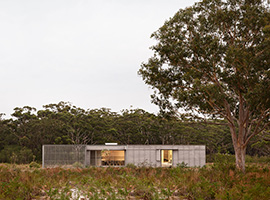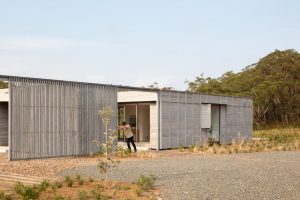An Off-Grid Prefab Home Slides Wide Open to the Australian Bush
Article written by Lucy Wang at "Dwell"
To read the original article, click here.
The self-sufficient Courtyard House embraces the bush landscape in all directions.
With over 30 years of experience in construction and development, Tony Olding believes he has seen the future of Australia’s building industry—and he’s doubling down on prefab.
To help drive the country toward eco-friendly prefabricated homes, Olding launched FABPREFAB in 2016, and he teamed up with Sydney-based architecture firm CHROFI to create one of his first modular models: the Courtyard House. The home is a modern take on traditional rural homes in Australia, and it’s able to operate entirely off the grid.
“Courtyard House is our first prefabricated housing project, but we’ve always been interested in the idea of efficiency in the use of space and material,” says CHROFI partner Tai Ropiha. The firm designed the home as a set of four modules—a living space, veranda, bedroom, and central bridge/hallway—along with a sliding timber screen.
The modules were built to 90% completion inside a factory—fittings, fixtures, tiles, and more were installed before the units were trucked to the site and placed atop the foundation in five hours.
The brief called for a home with a strong connection to the coastal bush landscape. “Because the building has no sense of a front, back, or side, it engages with the landscape on all sides,” explain the architects. “The veranda and enclosed courtyard provide a mediated connection between the interior and the rugged landscape.”
The 300-square-foot “reinterpreted” veranda is a sheltered room open to the outdoors.
The southwest-facing courtyard inspired the project’s name, and it creates a layout that disguises the narrow and linear proportions of the offset prefabricated modules. The open-air services core is located in the center of the home, rather at the rear or side, so as to avoid defining the envelope of the home.
“This leaves the house as a resolved three-dimensional object floating in space that can adapt to different site conditions,” explain the architects. “The built-in ability to rotate or mirror the plan means that, regardless of a site’s orientation or aspect, the Courtyard House is able to establish a strong connection to its immediate landscape in all directions.”
At 1,033 square feet in size, the Courtyard House is significantly smaller than the average Australian home. The design team decided to keep the footprint compact in order to minimize site impact and material use. In addition to these environmental considerations, the prefab home features passive systems for natural cooling, and it operates entirely off the grid by generating its own solar polar and harvesting rainwater. The home also has an on-site sewage treatment system.
The construction of the Courtyard House took approximately a year, including site and factory work. However, FABPREFAB construction manager Ed Callanan notes that future projects will have a reduced and streamlined timeline, given that this project was their first prototype.
The Courtyard House has since been sold to a related entity of FABPREFAB, and it will be listed on AirBnB in the near future. “This allows potential buyers to experience life inside the design prior to purchasing the model,” explains Olding.






